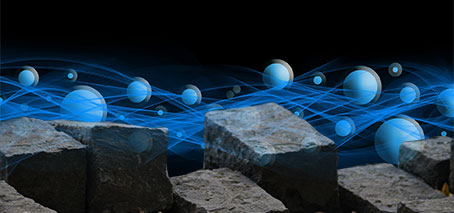Everything ‘quantum’ at the ARC Centre of Excellence in Future Low-Energy Electronics Technologies
FLEET’s research is intimately wrapped up in quantum science, spanning areas including quantum materials, quantum coherence, quantum entanglement, electronics, semiconductors, materials science, electronic devices and quantum education.
FLEET is exploiting new quantum phenomena to build new devices and technologies capable of vastly lowering the energy used in computation, ensuring a sustainable future for ICT.
All areas of FLEET research involve aspects of quantum physics, and all FLEET graduates and alumni are skilled to work in future quantum industries.
Quantum materials
Quantum materials
Wait, aren’t all materials ‘quantum’?
Well yes, but we use the phrase ‘quantum materials’ to refer to materials whose functional properties are dominated by quantum effects.
Similarly, all clocks are comprised of atoms, but we use the phrase ‘atomic clocks’ to describe clocks whose function utilises atomic-scale phenomena.
FLEET’s research is underpinned by novel quantum phenomena in materials.
So called ‘quantum materials’ include:
- Topological materials, in which the topological nature of quantum energy bands give rise to new conducting properties in materials
- Exciton-polaritons, quantum-entangled half-matter, half-light particles which may exhibit spontaneous quantum coherence and superfluid flow in solids
- Bose-Einstein condensates, quantum-coherent superfluids of atomic gases
- Ultrafast quantum control of materials properties using light pulses.
Quantum capabilities by university
FLEET is a collaboration between Monash University, Australian National University, University of New South Wales, University of Queensland, RMIT, Swinburne University of Technology, and University of Wollongong, comprising around 200 researchers. Quantum skills and capacity by university are:
-
- Monash University (Melbourne) quantum materials (multiferroics and topological materials) synthesis and characterisation (STM and AFM, ARPES), theoretical physics (many-body physics and DFT simulations), ultra-cold atomic collisions and non-linear dynamics (fundamental quantum phenomena), ultra-fast photonics, quantum sensing with diamond NV centres and Bose-Einstein condensates
- Australian National University (Canberra) Polariton BEC Research Group, experimental and theoretical quantum research into coherent states, non-classical states, non-equilibrium physics
- University of New South Wales (Sydney) Experimental and theoretical projects in Quantum Materials, Quantum Devices and Quantum Computing. Partnerships with industry and Sydney Quantum Academy. Groups at UNSW are developing new semiconductor and superconducting devices, ultra-fast hole spin qubits, quantum materials synthesis and characterisation, theoretical condensed matter physics (charge and spin transport, spin-orbit coupling, many-body physics), ferromaterials (quantum spin), and patterned electrical and magnetic order materials.
- University of Queensland (Brisbane) Theoretical studies of non-equilibrium states (BECs), driven quantum systems and quantum optics, collaborations with EQUS and Dodd Wall Centre NZ
- RMIT University (Melbourne) Theoretical quantum physics studies of decoherence in solid-state materials, collaborations with Exciton Science Centre, CQC2T
- Swinburne University of Technology (Melbourne) quantum gas microscope, ColdQuanta/Infleqtion partnership, ultra-cold atoms and coherent ultra-fast spectroscopy probing fundamental quantum superfluidity, superconductivity and band structure
- University of Wollongong (NSW) quantum materials synthesis and characterisation, superconductors and multiferroic materials, Institute for Superconducting & Electronic Materials
Supporting quantum literacy and the quantum ecosystem
FLEET plays a role in helping students and public understand the role of quantum sciences, better preparing a future Australian quantum-skilled workforce, and a quantum-savvy public. FLEET’s role in the larger Australian quantum ‘ecosystem’ includes:
- Integration of quantum fundamentals into an understanding of semiconductor operation and computing in FLEET’s Year 10 JMSS unit
- Primary school electricity classes aimed at introducing quantum concepts such as wave/particle duality and uncertainty
- Quantum and energy resources for schools
- Research and outreach alongside other ARC Centre of Excellence partners in quantum science (CQC2T, Exciton Science, EQUS)
- FLEET submission on national quantum strategy
- Involvement in workshops informing the new Australian Centre for Quantum Growth (ACQG).

